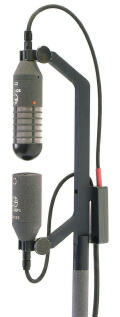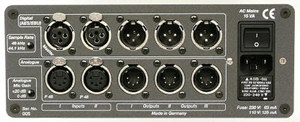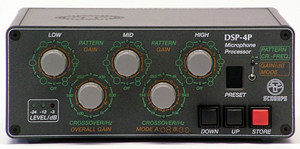POLARFLEX SYSTEM
DSP-4P PROCESSOR + 2x OMNI + FIGURE-8 / DSP-4P + 2x CMXY 4 V
FEATURES:
- Emulating the sound of any microphone
- Frequency response and polar response can be tailored
- The characteristics of the recording microphones can be chosen after the recording (post-processing in analog or digital domain)
- Digital and analog inputs and outputs
- Analog-style controls
- User-preference settings can be stored and recalled
|
|
 Omnidirectional microphone and Figure-8 microphone |
|
 DSP-4P Processor, rear view |

CMXY 4V |
Essential sonic differences between condenser microphones of the same nominal directional pattern are not due only to frequency response, but also to the fact that the polar pattern is seldom maintained uniformly throughout the entire frequency range, particularly at the lowest and highest frequencies. Though ostensibly a defect, this fact can also be used to advantage. While the frequency response at a given pickup angle can be controlled by equalizers, up to now there has been no way to alter the polar pattern correspondingly; that is, in specific frequency ranges. The only way to control this situation has been through the choice of microphones with different variations of the polar pattern versus frequency. But with the DSP-4P processor, not only can nearly ideal directional characteristics be selected, but also nearly any frequency-dependent directional characteristic that may be desired, e.g., a cardioid which becomes omnidirectional below the midrange, so that it has better response at the very lowest frequencies. This would allow X/Y or ORTF recordings to have nearly perfect reproduction of even the lowest frequencies (though the intensity difference between channels will of course decrease at those frequencies). Furthermore, in excessively reverberant spaces one could record a "drier" sound ("cardioid" or "supercardioid" setting) or -- in spaces that are dry -- accept more room reflections ("wide cardioid" or "omni" setting) in the corresponding frequency range. In such cases it is not the frequency response, but rather the ratio of direct to reflected sound which will be altered. That cannot be done with an equalizer, nor can a reverb unit reduce the degree of reflected sound after the fact.
The PolarFlex System
consists of:
- one pressure transducer (omni) and one figure-8 per channel
(alternatively, two cardioids can be used)
- the stereo DSP-4P polar modelling processor.
The first arrangement (top
right image) consists of:
1. An omnidirectional microphone with a mild high-frequency emphasis in
the direct soundfield (shown here: CCM 2 S). Because of its angle of orientation,
the capsule has an ideal directional response in the horizontal plane;
the high-frequency emphasis compensates for the high-frequency losses
due to lateral sound incidence.
2. A figure-8 microphone set directly above the omni; the direction in which it is aimed will determine the orientation of the resulting adjustable "virtual" microphone. The hemispherical device attached to the top of the figure-8 flattens the response of the omnidirectional microphone at the highest frequencies.
The alternate arrangement (bottom right image) consists of an X/Y stereo microphone, the Schoeps CMXY 4V. The two cardioids have been rotated to an included angle of 180°, so are aimed forward and backward, oriented so as to point in the direction og the resultanrt "virtual microphone."
Microphones other than the ones shown here can also be used. They must be small-diaphragm microphones however, since only those would have a sufficiently uniform directional characteristic throughout the frequency range. If the first arrangement (top right image) is being followed, the figure-8 microphone should have a flat frequency response, while the omni should have a slight diffuse-field equalization (a high-frequency emphasis as measured on axis).
The DSP-4P Processor:
The following settings can be made independently of one another in three adjustable frequency ranges: With the three knobs in the upper row, the directional patterns in each of the three frequency bands can be set. The settings are indicated by a circle of LEDs around each of the knobs. At the lower left of each knob is the omnidirectional setting; at the lower right is the figure-8 setting. Eleven intermediate pattern settings are available. The knobs in the lower row are set between those in the upper row. They are used for setting the boundaries between the frequency ranges: 100 Hz - 1 kHz and 1 kHz - 10 kHz respectively, in third-octave steps. The three buttons at the lower right are for storing and recalling presets.
If the unprocessed microphone signals have been recorded, these adjustments can be made during post-processing.
The processor operates at 24-bit resolution with either a 44.1kHz or a 48 kHz sampling rate. When a digital device is connected to the input, the PolarFlex processor adapts to its clock signal.
| Technical data of the DSP-4P PolarFlex Processor: | |
| Analog inputs/outputs: | |
| Input impedance: | 20 kOhm |
| Output impedance: | 100 Ohm |
| Digital inputs/outputs: | AES/EBU, 110 Ohm |
| Dynamic range: | |
| A/D converter: | 110 dB A-weighted, 98 dB (peak)/CCIR |
| D/A converter: | 110 dB A-weighted , 90 dB (peak)/CCIR |
| Coarse Gain (analog inputs): | +10 dB, +20 dB |
| Maximum input level (analog): | -14 dBU (+6 dBU) |
| Maximum output level: | +6 dBU |
| Maximum sound pressure level with CCM 2 S/CCM 8: | 130/132 dB SPL |
Complete PolarFlex System: $
2 x CCM 2 S Lg, 2 x CCM 8 Lg,
Mounting brackets, Y-cables and DSP-4P

